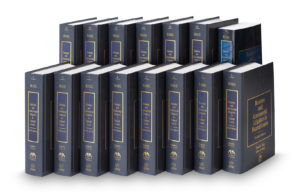
Business and Commercial Litigation in Federal Courts is a 14-volume treatise that has been aptly described by reviewers as breathtaking in its scope and breadth. To put it in the vernacular of students of procedural and constitutional law, it “preempts the field.”
Now in its Fourth Edition, this treatise – edited by prominent New York commercial litigator and legal scholar Robert L. Haig, who is a partner at Kelley Drye & Warren – covers virtually every imaginable topic and more than a few topics that most practitioners would not imagine would be addressed in a substantive or procedural federal court practice treatise.

Beyond the normal mainstream and core procedural subjects, such as subject matter and personal jurisdiction, venue, pleading, removal to federal court, parties, class actions, discovery, motion practice, dispositive motions, expert witnesses, evidence, attorneys’ fees, sanctions, appeals, and ethics, Business and Commercial Litigation is unusual because it goes much further and addresses substantive legal matters that are either unique to or regularly encountered in federal court litigation.
For example, the treatise includes expert analysis on Securities, Structured Finance, Derivatives, Commodities, Professional Liability, Admiralty and Maritime Law, Insurance, Letters of Credit, Aviation, Consumer Protection, Trademark and Copyright, OSHA, ERISA, RICO, Franchising, Foreign Corrupt Practices, False Claims Act, Civil Rights, Sports, and even Fashion and Retail.
Together, Business and Commercial Litigation’s procedural and substantive law scope would, of themselves, make a compelling resource. But there’s more!
The treatise delves deeply into real life issues and considerations that are not commonly addressed by scholarly discussions of proceedings in federal courts but permeate and are essential to a robust discussion of effective federal court litigation. These are the kinds of discussions and dialog regarding real world issues that thoughtful litigators have with their team (even when the “team” is only themselves). It blends academic, legal, strategic, tactical and practical concerns which recognize that the ultimate goal of litigation is a good result for the client achieved in a cost-effective, efficient and timely manner, and allows some reasonable degree of predictability of both the realistic range of results and the monetary and business costs likely to be incurred by the client.
As much as it would be professionally rewarding, it is not the goal of most clients to prevail at the Supreme Court six or seven years hence – they want as much certainty, predictability and closure as is reasonably possible now. Business and Commercial Litigation recognizes that an understanding, even a deep one, of the relevant substantive law and procedural rules on an academic and intellectual basis, while fundamental to obtaining a great result for the client, is not enough. Substantive and procedural analysis must be combined at every step with practical considerations.
The treatise provides guidance on both the former and the latter at virtually every phase in the evolution of the commercial dispute as it evolves from a business disagreement into a full-blown litigation when one side or the other literally decides to “make a federal case out of it.”
When I was a “baby” lawyer (too many years ago to be able to count without wondering how the years flew by), I was often given research assignments involving various specific areas of procedural and substantive law. After exhausting the normal approaches to addressing (and hopefully somewhat resolving) the discrete legal issues to which I had been assigned, I would usually take some time and review various legal treatises on a particular area of the law to see if an approach or issue that I or others had not yet thought about might provide a useful argument.
For instance, if significant contract issues dominated a case, after researching the assigned and other obvious issues, I might review Corbin on Contracts (both the single volume and multi-volume treatises) and the contract portions of Corpus Juris Secundum (“CJS”) – in particular the tables of contents or even the indexes — simply to see if I might come across a topic that generated or stimulated new ideas.
I often had the fantasy (admittedly a somewhat vanilla one for a former small town twenty-something overpaid single professional living in New York City with all of its temptations – but I digress) that I would stumble on a new strategy or argument and be hailed as the boy genius, wunderkind, or the like for coming up with an approach that none of my seniors had considered. Of course, I would likely describe my process to the partners as a mere example of my very deep thinking or unique intellectual prowess rather than just something I happened to “stumble upon”.
Business and Commercial Litigation provides a similar opportunity richly and easily for practitioners in the federal courts with respect to both federal practice and procedure as well as a wide swath of substantive law matters.
Significantly, the 296 principal authors of the treatise’s various chapters are not academics – although many of them are adjunct professors at law schools. Rather, they are highly regarded, experienced, passionate, business litigators and members of the judiciary.
To borrow a concept from fantasy baseball, if you were to put together a law firm with these 296 authors, (especially if you included the editor, Bob Haig), you would have the preeminent business and commercial litigation firm in the country. But of course that is just another fantasy on my part.
It is no overstatement to say these authors are at the top of their game and the top of the legal food chain. None of them, as they say in Texas, my adopted home of over thirty years, are “all hat and no cattle.”
Most compelling to me is that Business and Commercial Litigation covers matters not typically addressed in other legal resources – even encyclopedic treatises. While many treatises or similar works often have a paragraph or two towards the end of each chapter suggesting practical tips and comments, these comments are usually more of an afterthought or an aside. That is not the case here.
Business and Commercial Litigation’s considerable focus on – and equal treatment of – practical issues with the scholarly legal issues is what truly differentiates this treatise.

Specifically Business and Commercial Litigation provides deep guidance in subjects that do not fall nicely into either “procedural” or “substantive law” categories but are of immense practical importance in successfully conducting and managing business and commercial litigation in the federal courts. To name just a few: Litigation Avoidance and Prevention; Litigation Technology; Social Media; Law Firm and Corporate Litigation Management; Marketing to Potential Business Clients (of course, without clients you and your firm will not be doing much litigation in the federal courts –or anywhere else for that matter); Teaching Litigation Skills; Pro Bono; Ethical Issues in Commercial Cases; and Civility.
As an attorney who has morphed from a front line hard core business litigator into a role primarily as an ADR focused practitioner – both as a neutral mediator and arbitrator, as well as maintaining a significant practice as a non-neutral negotiator/settlement counsel – I find that the portions relating to settlement, negotiation and ADR are particularly significant and exemplify Bob Haig’s vision of the treatise addressing real life issues.
As we are all fully aware, most complex business litigation in federal court (and in most state courts) is resolved by settlement either at mediation or by direct negotiations among lawyers, often with the help of a mediator or ADR provider or possibly a settlement judge at some point in the negotiation and settlement process.
The enactment of the Civil Justice Reform Act of 1990 and the Civil Justice Expense and Delay Reduction plans and associated local rules adopted by the federal district courts to implement the mandate of the law have made mediation and settlement, as well as other ADR methods, standard operating procedure in virtually all federal district courts. Indeed, engaging in some sort of ADR process – typically mediation – is usually much more than a “suggestion” by the district court and is often part of the scheduling order and a prerequisite to going to trial.
It is beyond peradventure that many more cases are resolved at mediation or by direct settlement negotiations among counsel than are resolved by trial in federal courts. If lawyers do not have the skill set, knowledge and resources to fully manage (and properly exploit) the negotiation, settlement, and ADR processes, they, and more importantly their clients, will be at a material disadvantage.
Because of the nature of my practice, I am going to briefly focus on the portions of Business and Commercial Litigation dealing with ADR, settlement and negotiation – matters that have not routinely been part of the law school curriculum until relatively recently and are usually elective courses. These are subjects most lawyers have traditionally “learned by doing” after starting to practice (often learning by or repeating their mistakes for years) but without the same systematic, analytical and thoughtful strategy and approach brought to the typical hard core litigation and trial matters.
Business and Commercial Litigation provides the resources to jumpstart a logical and systematic approach to settlement and the management and implementation of an effective ADR process and strategy in federal court. Chapter 35, Settlements (Bruce Ericson); Chapter 50, Negotiations (Julian Solotorovsky and Matthew Luzadder); Chapter 51, Mediation (Daniel Weinstein and Cedric Chao); and Chapter 52, Arbitration (James Schurz and Louise Stoupe) are quite simply first rate, comprehensive, and of immense practical use.
Let’s look at the chapter on Settlement as an example:
• It starts with a discussion of understanding the client objectives (pretty self-evident but often not truly vetted early and often);
• It includes a section on the litigation budget and case evaluation, which together with the budget and other cost issues constitute the alternative to settlement or in negotiation parlance the client’s “BATNA” (Best Alternative To a Negotiated Agreement);
• It continues into discussions of the timing of settlement and the dynamics of pre-suit settlement, including how to initiate settlement discussions without appearing anxious or weak, exploiting and utilizing ADR processes, settlement judges, offers of judgement under F.R.C.P. 68, and even the use of a designated settlement lawyer – a concept near and dear to my own heart.
The author of the Settlement chapter lays out some basic settlement strategies that many lawyers may not have put into a conscious analytic, systematic, or strategic framework but have sub-consciously implemented in an ad hoc or somewhat extemporaneous manner. These include the classic “good cop/bad cop” or “limited authority” approaches, to name two of the most well-known negotiating tactics, as well as many more nuanced and sophisticated negotiation and settlement stratagems.
The other ADR chapters provide insight and other ideas – with surprisingly little overlap – to enhance the effectiveness of even seasoned and experienced counsel in the settlement context. My suggestion is to use the chapters on ADR, especially the chapters on settlement, negotiation, and mediation, not as simple tutorials to be read and absorbed as part of your general learning on the subjects of negotiation and settlement, but rather as a sort of global, big picture checklist to review each time you are faced with planning and developing a negotiation and settlement strategy and as the settlement dynamics change and evolve throughout a case. Reviewing each chapter will generate ideas that would otherwise get lost in the hectic lives of busy and successful litigators who always have a lengthy “to do” list for the litigation proper. In fact, if the ADR chapters in this treatise simply cause you to systematically think about and prepare a planned negotiation and settlement strategy, you are well ahead of the game and most other litigators.
Business and Commercial Litigation is available both in electronic and hard copy form. I am somewhat partial to the hard copy. Although it is not quite as portable (about 2 ½ feet overall), there is something about the feel of holding and reading an actual book that simply feels better than a computer screen and, for me, is easier to browse. In rich navy blue with gold lettering, the 14 volumes look great on a modest sized bookshelf in a private office. They should be kept as part of a personal library and close at hand to facilitate simply grabbing the appropriate volume and going on a “treasure hunt”. That is my own personal plan. Of course, the electronic version allows you to do the same at home or when traveling or if you simply prefer to browse on a computer or tablet.
While I obviously did not read all 14-volumes page-by-page or even intently review every chapter, I would lay odds that Bob Haig did the former – likely more than once – as part of his editing and “birthing” process.
Finally, although Bob Haig is based in New York City, I am particularly pleased that so many of the authors of Business and Commercial Litigation are my fellow Texas lawyers – many of whom are friends and colleagues with whom I have worked over the years. These include David Beck, Judge Barbara Lynn, David Coale, Rod Phelan, Van Beckwith, and Chip Babcock.
We have some of the finest litigators and true trial lawyers in the country in Texas and a very advanced ADR practice and tradition in our state and federal courts. This treatise will make those who use it even better lawyers and their clients better served.
Christopher Nolland is a Dallas attorney who specializes in complex commercial mediation and arbitration. A member of the American College of Civil Trial Mediators, Nolland also is frequently hired by clients as a non-neutral settlement counsel in large business, probate, fiduciary duty, and insolvency related disputes. Mr. Nolland is an adjunct professor at SMU Dedman School of Law where he has taught Legal Negotiation to 2Ls and 3Ls for over twenty years.
